- Clone
- O323 (See other available formats)
- Regulatory Status
- RUO
- Workshop
- IV T-186
- Other Names
- S152, T14, TNFRSF7
- Isotype
- Mouse IgG1, κ
- Ave. Rating
- Submit a Review
- Product Citations
- publications
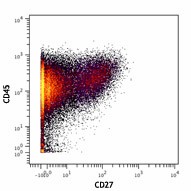
-

Human PBMCs stained with 154Sm-anti-CD45 (HI30) and 167Er-anti-CD27 (O323). Data provided by DVS Sciences.
| Cat # | Size | Price | Quantity Check Availability | Save | ||
|---|---|---|---|---|---|---|
| 302839 | 100 µg | 129 CHF | ||||
CD27 is a 50-55 kD type I membrane protein also known as S152 and T14. It is a lymphocyte-specific member of the TNF-receptor superfamily. CD27 is expressed on medullary thymocytes, virtually all mature T cells, some B cells, and NK cells. CD27 binds to CD70 and plays an important role in costimulation of T cell activation, and regulation of B cell differentiation and proliferation. The cytoplasmic domains of CD27 have also been shown to interact with TRAF2 and TRAF5 to elicit NF-κB and SAPK/JNK activation.
Product DetailsProduct Details
- Verified Reactivity
- Human, Cynomolgus, Rhesus
- Reported Reactivity
- African Green, Baboon, Squirrel Monkey
- Antibody Type
- Monoclonal
- Host Species
- Mouse
- Formulation
- Phosphate-buffered solution, pH 7.2, containing 0.09% sodium azide and EDTA.
- Preparation
- The antibody was purified by affinity chromatography.
- Concentration
- 1.0 mg/ml
- Storage & Handling
- The antibody solution should be stored undiluted between 2°C and 8°C.
- Application
-
FC - Quality tested
CyTOF® - Verified - Recommended Usage
-
This product is suitable for use with the Maxpar® Metal Labeling Kits. For metal labeling using Maxpar® Ready antibodies, proceed directly to the step to Partially Reduce the Antibody by adding 100 µl of Maxpar® Ready antibody to 100 µl of 4 mM TCEP-R in a 50 kDa filter and continue with the protocol. Always refer to the latest version of Maxpar® User Guide when conjugating Maxpar® Ready antibodies.
- Additional Product Notes
-
Maxpar® is a registered trademark of Standard BioTools Inc.
-
Application References
(PubMed link indicates BioLegend citation) -
- Knapp W, et al. Eds. 1989. Leucocyte Typing IV. Oxford University Press. New York.
- Correia DV, et al. 2011. Blood 118:992. (FC) PubMed
- Product Citations
-
- RRID
-
AB_2562817 (BioLegend Cat. No. 302839)
Antigen Details
- Structure
- TNF-R superfamily, type I transmembrane glycoprotein, 50-55 kD
- Distribution
-
Medullary thymocytes, T and B cell subsets, NK cells
- Function
- T cell costimulation
- Ligand/Receptor
- CD70
- Cell Type
- B cells, NK cells, T cells, Thymocytes, Tregs
- Biology Area
- Costimulatory Molecules, Immunology
- Molecular Family
- CD Molecules
- Antigen References
-
1. Hintzen R, et al. 1994. Immunol. Today 15:307.
2. Agematsu K, et al. 1995. J. Immunol. 154:3627. - Gene ID
- 939 View all products for this Gene ID
- UniProt
- View information about CD27 on UniProt.org
Related FAQs
- Can I obtain CyTOF data related to your Maxpar® Ready antibody clones?
-
We do not test our antibodies by mass cytometry or on a CyTOF machine in-house. The data displayed on our website is provided by Fluidigm®. Please contact Fluidigm® directly for additional data and further details.
- Can I use Maxpar® Ready format clones for flow cytometry staining?
-
We have not tested the Maxpar® Ready antibodies formulated in solution containing EDTA for flow cytometry staining. While it is likely that this will work in majority of the situations, it is best to use the non-EDTA formulated version of the same clone for flow cytometry testing. The presence of EDTA in some situations might negatively affect staining.
- I am having difficulty observing a signal after conjugating a metal tag to your Maxpar® antibody. Please help troubleshoot.
-
We only supply the antibody and not test that in house. Please contact Fluidigm® directly for troubleshooting advice: http://techsupport.fluidigm.com/
- Is there a difference between buffer formulations related to Maxpar® Ready and purified format antibodies?
-
The Maxpar® Ready format antibody clones are formulated in Phosphate-buffered solution, pH 7.2, containing 0.09% sodium azide and EDTA. The regular purified format clones are formulated in solution that does not contain any EDTA. Both formulations are however without any extra carrier proteins.
Other Formats
View All CD27 Reagents Request Custom ConjugationCustomers Also Purchased
Compare Data Across All Formats
This data display is provided for general comparisons between formats.
Your actual data may vary due to variations in samples, target cells, instruments and their settings, staining conditions, and other factors.
If you need assistance with selecting the best format contact our expert technical support team.
-
APC anti-human CD27
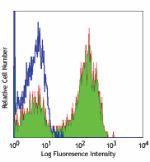
Human peripheral blood lymphocytes stained with O323 APC -
Biotin anti-human CD27
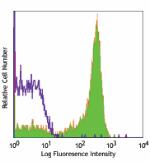
Human peripheral blood lymphocytes stained with biotinylated... -
FITC anti-human CD27

Human peripheral blood lymphocytes stained with O323 FITC -
PE anti-human CD27

Human peripheral blood lymphocytes stained with O323 PE 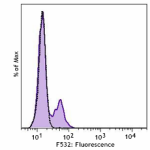
PE anti-human CD27 Antibody Human peripheral blood was stai... -
Purified anti-human CD27

Human peripheral blood lymphocytes stained with purified O32... -
Alexa Fluor® 647 anti-human CD27
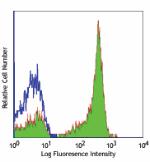
Human peripheral blood lymphocytes stained with O323 Alexa F... -
Alexa Fluor® 700 anti-human CD27
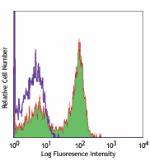
Human peripheral blood lymphocytes stained with O323 Alexa F... -
APC/Cyanine7 anti-human CD27
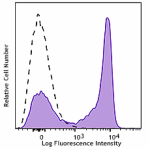
Human peripheral blood lymphocytes stained with CD27 (clone ... -
PerCP anti-human CD27
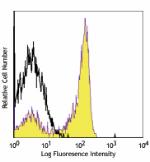
Human peripheral blood lymphocytes stained with O323 PerCP -
PerCP/Cyanine5.5 anti-human CD27
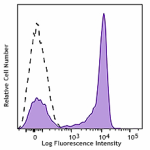
Human peripheral blood lymphocytes were stained with CD27 (C... -
Pacific Blue™ anti-human CD27
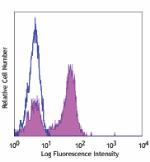
Human peripheral blood lymphocytes stained with O323 Pacific... -
Brilliant Violet 421™ anti-human CD27
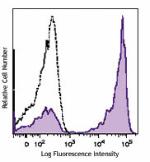
Human peripheral blood lymphocytes were stained with CD27 (c... -
Brilliant Violet 570™ anti-human CD27

Human peripheral blood lymphocytes were stained with CD27 (c... -
Brilliant Violet 650™ anti-human CD27
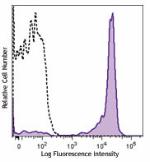
Human peripheral blood lymphocytes were stained with CD27 (c... -
Brilliant Violet 605™ anti-human CD27
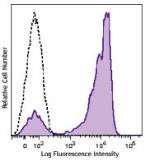
Human peripheral blood lymphocytes were stained with CD27 (c... -
Brilliant Violet 711™ anti-human CD27

Human peripheral blood lymphocytes were stained with CD27 (c... -
Brilliant Violet 785™ anti-human CD27
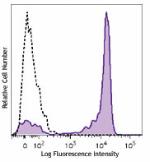
Human peripheral blood lymphocytes were stained with CD27 (c... -
Brilliant Violet 510™ anti-human CD27

Human peripheral blood lymphocytes were stained with CD27 (c... -
PE/Cyanine7 anti-human CD27
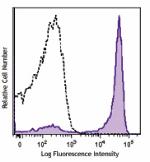
Human peripheral blood lymphocytes were stained with CD27 (c... -
Purified anti-human CD27 (Maxpar® Ready)
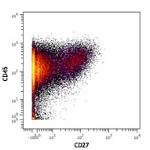
Human PBMCs stained with 154Sm-anti-CD45 (HI30) and 167Er-an... -
PE/Dazzle™ 594 anti-human CD27
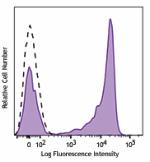
Human peripheral blood lymphocytes were stained with CD27 (c... -
APC/Fire™ 750 anti-human CD27
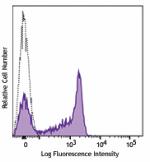
Human peripheral blood lymphocytes were stained with CD27 (c... -
TotalSeq™-A0154 anti-human CD27
-
Brilliant Violet 750™ anti-human CD27

Human peripheral blood lymphocytes were stained with CD27 (c... -
TotalSeq™-B0154 anti-human CD27
-
TotalSeq™-C0154 anti-human CD27
-
Spark NIR™ 685 anti-human CD27

Human peripheral blood lymphocytes were stained with CD27 (c... -
PE/Fire™ 810 anti-human CD27

Human peripheral lymphocytes were stained with CD27 (clone O... -
TotalSeq™-D0154 anti-human CD27
-
APC/Fire™ 810 anti-human CD27

Human peripheral lymphocytes were stained with anti-human CD... -
PE/Cyanine5 anti-human CD27 Antibody

Human peripheral blood lymphocytes were stained with anti-hu... -
Spark UV™ 387 anti-human CD27
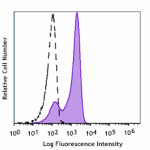
Human peripheral blood lymphocytes were stained with anti-hu... -
Spark Blue™ 515 anti-human CD27

Human peripheral blood lymphocytes were stained with anti-hu...
 Login / Register
Login / Register 










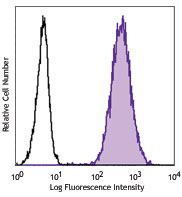
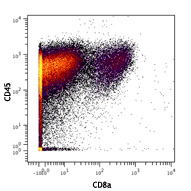

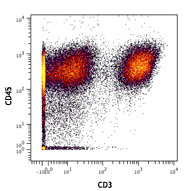



Follow Us